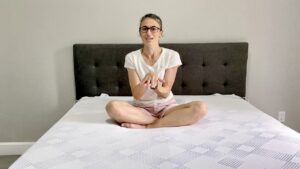SLEEP SANCTUARY: 8 STEPS TO CREATING THE PERFECT HAVEN FOR REST AND RESTORATION
In today’s fast-paced world, getting a good night’s sleep has become increasingly challenging. The demands of work, addicting technology, self-afflicted pressure, and the constant stimulation from our surroundings often leave us feeling exhausted and sleep-deprived.
However, turning your bedroom into a sleep sanctuary – a peaceful and conducive environment for rest and restoration – is essential for optimizing your sleep quality and overall well-being (physical and mental). In this article, we will explore the various elements that contribute to creating a sleep sanctuary, and provide practical tips to help you transform your bedroom into the perfect haven for rest and restoration.
Here are 8 steps you can take today, to improve your sleep and well-being.
Table of Contents
1- Declutter and Simplify
Creating a serene sleep sanctuary starts with decluttering your bedroom. A cluttered room, and/or home, leads to an overall feeling of distraction and and an unconscious need to address the situation. It keeps your mind busy, even if you do not notice it. Your eyes and brain are constantly assessing the situation, and the clutter stays in the back of your mind. Instead of feeling free and relaxed, the clutter created a sentiment of stress and anxiety.
A clutter-free environment, not only promotes relaxation, but also helps reduce distractions and create a sense of order. This first step is easy to action: begin by removing unnecessary items, organize your belongings, and find storage solutions for any remaining clutter. If you get overwhelmed with the task, create piles to start with. It is an easy and quick way to start seeing surfaces on desks, floors, tables, countertops. Once you have clean and organized piles, go through them one and one, and put away or discard, as needed. The goal is to slowly get to the point where all surfaces are clear.
Once they are, opt for minimalistic decor to create a calm and peaceful atmosphere that encourages restful sleep. We recommend using natural materials for your decor, and keeping the colors earth-tone, pastel, and/or soothing.
2- Set the Right Mood with Lighting
Lighting plays a crucial role in regulating our sleep-wake cycle, also known as the circadian rhythm. To create a sleep-friendly environment, prioritize natural light during the day and minimize artificial light at night.
During the day, open your curtains or blinds to let in as much natural light as possible. If you are not living in a very humid environment, we also recommend opening your windows for about 15 minutes, first thing in the morning, to help recycle your bedroom air with fresh air.
In the evening, pull your blackout curtains, dim the lights and consider using warm, soft lighting bulbs in at least your bedside lamps. Doing so will give a cozy hue to your room after you turn off the main ceiling light, and set the mind for winding down as you read or exercise nighttime meditation. We recommend a bedside lamp with adjustable brightness, to control the mood you want to achieve, based on your needs and feelings (which can change daily).
At least an hour before going to sleep, avoid blue light from electronic devices and your TV screen. Blue light mimics sun light and confuses your body and mind. It can suppress the production of melatonin, a hormone that promotes sleep, and prevent you from falling asleep when you need to.
3- Choose Soothing Colors
Colors have a significant impact on our emotions and can influence our state of mind and relaxation. Each color has a specific emotional and psychological connotation. While many connotation are universal, some are very personal and impacted by a person’s culture. When it comes to setting up your sleep sanctuary, opt for calming and soothing colors that promote relaxation. Soft neutrals, cool blues, gentle greens, or muted pastels are excellent choices for your bedroom walls and bedding.
These colors create a peaceful ambiance, helping to induce a sense of tranquility and peace, and preparing your mind and body for a restful night’s sleep.
Looking at the London Image Institute‘s “Meaning of Colors,” the following colors tend to invoke the following feeling:
- white: clean, simplicity
- brown: trustworthy, simple
- blue: peace, trust
- green: nature, healing
- yellow: happiness, warmth
Because pastel colors are less saturated, they often bring out calming and peaceful vibes, which can work really well for bedrooms. They will give out a sense of peace and relaxation to your room in no time.
4- Invest in Comfortable Bedding
Do you know that feeling of buttery soft, as you first lay in a freshly-made bed? The one you associate with luxury hotels, where getting out of bed is made difficult, and you could spend all day snuggling with your pillow instead?
The quality of your bedding directly affects your sleep experience. Start by investing in a comfortable mattress that supports your body and aligns your spine. This will be your first step in increasing the quality of your sleep. Do not overlook your pillow, as it further aligns the top of your spine, setting the scene for the rest of your body.
Choose bedding made of natural fibers like organic cotton, viscose from bamboo, eucalyptus, or linen, as they are breathable, buttery soft, and help regulate body temperature. In our opinion, and after testing dozens of sheets, the softest material is viscose from bamboo! Eucalyptus comes next, with organic cotton using the sateen weave, still being an excellent option. Linen can be incredibly soft too, and it will be a matter of personal preference, whether linen is for sure. We think it looks gorgeous, earthy, calming, and sleeps very soft! But really, you can’t go wrong with any of those 4 materials. They all make for excellent bedding!
If you are not ready to change your mattress, consider using a mattress topper or pad for extra comfort. You can find them in different firmness levels and with properties that match your sleeping style and preferences.
Lastly, experiment with different types of blankets or comforters, and find the perfect balance between warmth and weight to enhance your sleep sanctuary. If you like touch therapy, we highly recommend investing in a weighted comforter. The one under this link overhangs the sides of your bed, like a regular comforter, and has the option for a linen cover, that is incredible and does not peel.
5- Create a Calming Sound Environment:
External noise can disrupt your sleeping environment and prevent you from falling asleep, and/or achieving deep, restorative rest. To counteract disturbing noise, consider introducing calming sounds into your sleep sanctuary.
White noise machines, guided medications, nature sound recordings, or soothing instrumental music can help mask unwanted noises and create a peaceful environment. You can use a timer on your Amazon Alexa or Google Assistant to enable automatic powering off of your device after a given time frame. Our favorite way to block unwanted noises, is with this free library of guided meditations, breathworks, music, courses, and yoga sessions. With small headphones, or simply through your phone’s speaker, it can be very effective at creating a calm and focused environment, blocking out noises and distractions from your surroundings.
Alternatively, you can use noise-canceling earplugs if you are sensitive to sounds or live in a particularly noisy area. Those are small enough to be slept with, and will not create discomfort, even for side-sleepers.
6- Maintain Optimal Temperature and Humidity
The temperature and humidity of your bedroom significantly impact your sleep quality. Studies suggest that a cool room, around 65°F (18°C), promotes better sleep. While this is a good temperature on cold winter days, if you live in hot and humid southern states, it would put some serious stress on your wallet, and the planet. For those hot nights, turn the A/C down to 78°F (25°C) and use a fan over your bed.
Additionally, maintaining proper humidity levels, ideally between 40% and 60%, helps prevent dryness or excessive moisture in the air, ensuring a comfortable sleep environment. If you do control your room’s humidity levels, note that the warmer the air, the more moisture it holds.
If you struggle with feeling cold or hot at night, or if you and your partners have different preferences that prevent you from turning your room into a sleep sanctuary, we recommend adding a bed cooling system, which controls the temperature (heating or cooling) of each partner’s side of his/her bed. Some of those systems even use the power of AI to make adjustments during the night, to keep you asleep deeper and longer.
7- Banish Electronics and Distractions
In today’s digital age, electronic devices have become a constant presence and pressure in our lives. However, the blue light emitted by screens can disrupt sleep patterns and hinder the production of melatonin, which is the sleep hormone. Why you ask? Because blue light mimics sun light, confusing your brain and body into thinking it is day time.
Create a strict “no electronics” policy in your sleep sanctuary by removing all screens from the bedroom. Instead, encourage activities that promote relaxation, such as reading a book, practicing meditation, or journaling before bed.
8- Incorporate Relaxation Techniques
To further enhance your sleep sanctuary, consider incorporating relaxation techniques into your bedtime routine. Engage in activities that help you unwind, such as gentle stretching, deep breathing exercises, or a warm bath. There are so many incredible tools today, including our favorite free app full of free guided meditations geared towards breathwork, finding sleep, and more. We love that you do not need to look at your screen to use the app, and you can simply use headphones to zoned out external noises and distractions.
While we always recommend you live a healthy and active lifestyle, avoid stimulating or stressful activities close to bedtime. Try to establish a consistent sleep schedule to regulate your body’s internal clock and fall asleep faster.
Sleep Sanctuary - Creating The Perfect Haven For Rest And Restoration
Transforming your bedroom into a sleep sanctuary is a powerful step towards improving your sleep quality and overall well-being. By implementing the elements discussed in this article, such as decluttering, optimizing lighting, choosing soothing colors, investing in comfortable bedding, and banishing distractions, you can create an environment that promotes relaxation and restful sleep. Remember, a sleep sanctuary is a personal haven tailored to your preferences, so feel free to experiment and make adjustments until you find what works best for you. Prioritize your sleep, and you will reap the benefits of a well-rested mind and body, ready to conquer each day with renewed energy and vitality.
References
- London Image Insitute. (2020). Color Physchology: How Do Colors Affect Mood And Emotions. Retrieved from https://londonimageinstitute.com/how-to-empower-yourself-with-color-psychology/
- NASA Jet Propulsion Laboratory. Understanding Climate – Ocean Surface Topography From Space. Retrieved from https://sealevel.jpl.nasa.gov/ocean-observation/understanding-climate/air-and-water/
- Cleveland Clinic. (2021). The Best Temperature To Sleep. Retrieved from https://health.clevelandclinic.org/what-is-the-ideal-sleeping-temperature-for-my-bedroom/
FAQ
Most frequent questions and answers
To create a calming atmosphere, start by choosing soothing colors for the walls and bedding. Soft neutrals, cool blues, or gentle greens can help create a serene environment. Use lighting strategically by opting for warm, dimmable lights or bedside lamps with adjustable brightness. Consider incorporating elements from nature, such as plants or natural materials, to add a sense of tranquility. Decluttering and minimizing distractions also contribute to a calm ambiance.
Natural fibers like cotton or linen are popular choices for bedding due to their breathability, softness, and ability to regulate body temperature. These materials promote airflow and help wick away moisture, keeping you cool and comfortable during sleep. Additionally, hypoallergenic bedding options are available for those with sensitivities or allergies. It’s recommended to choose high-quality fabrics that feel comfortable against your skin.
Noise can disrupt sleep, but there are several ways to minimize its impact. Consider using soundproofing techniques, such as adding weatherstripping to windows and doors or using heavy curtains to block outside noise. White noise machines, fans, or even earplugs can also help mask unwanted sounds. If possible, identify and address the source of the noise, such as fixing squeaky floors or investing in soundproofing materials for walls.
The ideal temperature for a sleep-friendly bedroom is typically around 65°F (18°C). Cooler temperatures can promote better sleep quality. As for humidity, maintaining levels between 40% and 60% is recommended. This range helps prevent excessive dryness or moisture in the air, contributing to a comfortable sleep environment. Fans, air conditioners, humidifiers, or dehumidifiers can be used to regulate temperature and humidity levels based on personal preferences and local climate.
Certain scents have been known to promote relaxation and improve sleep quality. Lavender, chamomile, and jasmine are popular choices for their calming properties. Consider incorporating these scents into your sleep sanctuary through essential oils, linen sprays, or scented candles. Experiment with different aromas to find the ones that are most soothing and conducive to your sleep.
More Sleep Resources

What Is Luften | How, When, How Much, and Everything Else You Should Know
WHAT IS LUFTEN What, How, When, And Everything Else If you are looking for simple, yet effective, ways to boost your health, improve your sleep,

Best Pillow For Sore Neck
BEST PILLOW FOR SORE NECK Our Top Picks and Expert Tips for Pain-Free Sleep A sore neck can disrupt your entire day—and a bad pillow

5 Benefits of Memory Foam Mattresses | Why They’re Worth Considering for Better Sleep
5 BENEFITS OF MEMORY FOAM MATTRESSES Why They’re Worth Considering for Better Sleep Memory foam mattresses have become a go-to choice for sleepers seeking comfort,

How Does Sleep Improve Memory?
HOW DOES SLEEP IMPROVE MEMORY? Make Sleep a Priority for Better Memory In today’s fast-paced world, where productivity is often prioritized over rest, many underestimate
How can I create a calming atmosphere in my bedroom?
To create a calming atmosphere, start by choosing soothing colors for the walls and bedding. Soft neutrals, cool blues, or gentle greens can help create a serene environment. Use lighting strategically by opting for warm, dimmable lights or bedside lamps with adjustable brightness. Consider incorporating elements from nature, such as plants or natural materials, to add a sense of tranquility. Decluttering and minimizing distractions also contribute to a calm ambiance.
Are there specific fabrics or materials that are better for bedding?
Natural fibers like cotton or linen are popular choices for bedding due to their breathability, softness, and ability to regulate body temperature. These materials promote airflow and help wick away moisture, keeping you cool and comfortable during sleep. Additionally, hypoallergenic bedding options are available for those with sensitivities or allergies. It's recommended to choose high-quality fabrics that feel comfortable against your skin.
How can I reduce noise in my bedroom for better sleep?
Noise can disrupt sleep, but there are several ways to minimize its impact. Consider using soundproofing techniques, such as adding weatherstripping to windows and doors or using heavy curtains to block outside noise. White noise machines, fans, or even earplugs can also help mask unwanted sounds. If possible, identify and address the source of the noise, such as fixing squeaky floors or investing in soundproofing materials for walls.
What temperature and humidity levels are ideal for a sleep-friendly bedroom?
The ideal temperature for a sleep-friendly bedroom is typically around 65°F (18°C). Cooler temperatures can promote better sleep quality. As for humidity, maintaining levels between 40% and 60% is recommended. This range helps prevent excessive dryness or moisture in the air, contributing to a comfortable sleep environment. Fans, air conditioners, humidifiers, or dehumidifiers can be used to regulate temperature and humidity levels based on personal preferences and local climate.
Are there specific scents or aromas that can help improve sleep quality?
Certain scents have been known to promote relaxation and improve sleep quality. Lavender, chamomile, and jasmine are popular choices for their calming properties. Consider incorporating these scents into your sleep sanctuary through essential oils, linen sprays, or scented candles. Experiment with different aromas to find the ones that are most soothing and conducive to your sleep.
Share this deal with a friend!

Laura Georgieff
Laura is a mother of three who did not sleep through the night for the first 5.5 years of her kids' lives. She is passionate about sleep quality and loves sharing her experience and knowledge of all thing bedding! It is her mission to help you make the best decisions when it comes to sleep and help you get the best deal on the market!


